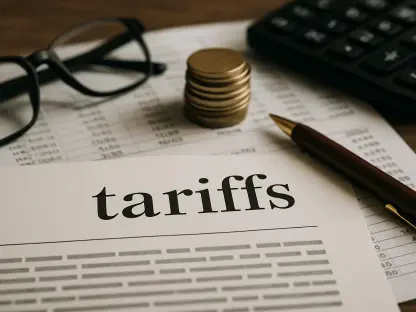The economic landscape of the Asia Pacific region is currently under significant scrutiny with the looming expiration of a crucial tariff pause, affecting investor sentiment across varied markets. In this volatile environment, the interplay between trade policies and currency dynamics becomes increasingly crucial for understanding broader market trends in the region. As the White House contemplates vital tariff decisions, market participants are closely monitoring developments that could bring substantial economic repercussions. Meanwhile, financial analysts focus on commodity markets, particularly gold and oil, which are experiencing notable shifts due to fluctuations in the US dollar. This scenario underlines the complexities involved in navigating financial markets where geopolitical actions directly impact asset values and investor decisions.
Asia Pacific Equities Respond to Tariff Uncertainty
Market Sentiments and Investment Dynamics
Major equity indices across the Asia Pacific opened the week with signs of distress, reflecting cautious investor behavior ahead of the anticipated ratification of higher tariffs by the White House. This hesitancy is primarily influenced by the approaching expiration date of the 90-day suspension on imposing additional tariffs, leaving investors in a precarious wait-and-see mode. Japanese and Hong Kong markets, represented by the Nikkei 225 and Hang Seng Index, respectively, observed tangible declines in performance, signifying broader apprehensions. Meanwhile, Singapore’s Straits Times Index displayed contrarian behavior by posting a slight gain, driven by intrinsic local economic factors that provided an unexpected high amidst regional uncertainty.
The Influence of White House Trade Policy
The ambiguity surrounding tariff implementation has perpetuated market anxieties, further exacerbated by contradictory signals from Washington. While Commerce Secretary Lutnick’s remarks suggested a possible postponement to August, offering a semblance of respite, President Trump’s proactive stance on initiating the communication process regarding tariffs highlights the firm resolve toward maintaining the July 9 deadline. This discrepancy contributes to heightened market volatility as stakeholders speculate on the potential repercussions these variables may engender. As such, equity markets remain attentive to any shifts in policy tone, striving to align investment strategies with anticipated fiscal adjustments.
Currency and Commodity Market Reactions
US Dollar Dynamics and Regional Currency Effects
The US dollar attained a modest recovery, registering a gain that allowed it to ascend within the context of the US Dollar Index, yet it remains restrained under the technical confines of its 20-day moving average. This rebound in the US dollar exerted pressure on several commodity-linked currencies prevalent within the Asia Pacific, including the yen, Australian dollar, and New Zealand dollar, each experiencing tangible declines. Traders and investors closely follow these movements, understanding their critical role in shaping global financial flows and the ensuing implications on trade partnerships and economic stability across the region.
Gold and Oil Trading Under New Influences
Gold markets faced a downturn, marked by prices dropping below the 50-day moving average, largely attributed to the dollar’s apparent fortitude. Such developments are pivotal, as gold often serves as a hedge against currency fluctuations, thereby underscoring strategic recalibrations among traders. Similarly, the crude oil market sustained losses, continued from the previous week, further dwindling by 0.4%. Key drivers include OPEC+’s production decisions that diverged from market anticipations, revealing concerns over excess supply amid fluctuating demand dynamics. These patterns denote a broader reaction to geopolitical and macroeconomic variables, necessitating agile investment approaches.
Economic Data and Analytical Perspectives
Understanding Market Movements and Indicators
Recent economic data releases furnish valuable insight into unfolding market phenomena, helping contextualize the erratic behavior observed in various sectors. Analysts and investors leverage such data to discern patterns and make informed decisions while strategizing around prevailing fiscal policies and economic forecasts. Detailed analysis of currencies such as the GBP/USD highlights persisting bearish trends despite periodic rebounds, reflecting underlying pressures that continue to influence currency valuations. Traders are urged to adopt comprehensive approaches, considering multifaceted variables that may reshape traditional market expectations.
Synthesis of Market Analysis
The intricate interconnections between geo-economic agendas and market performance present a coherent narrative depicting the sensitivity of equity and commodity markets to external stimuli. The article analytically integrates pertinent data, discerning the impacts of tariff timelines, currency adaptations, and commodity pricing on investment strategies across the Asia Pacific. Examining these elements within a unified analytical framework offers readers the necessary clarity and depth to appreciate complex market phenomena and anticipate potential variabilities arising from ongoing geopolitical developments.
Global Market Implications and Emerging Trends
Investor Hesitation and Strategy Shifts
Investor caution attributable to trade policy uncertainty emerges as a recurring theme, primarily affecting equity markets throughout the Asia Pacific region. This is observable in prevailing bearish sentiment among market participants, geared towards mitigating anticipated risks by recalibrating investment portfolios. Outside of localized factors positively influencing Singapore’s financial sphere, broader regional hesitations persist, reflecting deeper concerns over potential economic ramifications linked to tariff policies. The formulation of strategic approaches that account for these oscillating variables becomes crucial in fortifying investment decisions against unforeseen economic tremors.
The Role of Currency and Commodity Interplay
The strengthening US dollar exerts significant influence on commodity currencies, causing notable depreciation in Asian markets. These movements indicate broader ramifications as financial sectors across varying countries adjust to currency developments relative to global exchange rates. Predictably, commodity markets reciprocate this pivot, witnessing fluctuations wrought by shifting price pressures dictated by exchange rate variabilities. Such scenarios necessitate strategic agility, prompting traders and investors to adopt innovative hedging techniques to buffer against potential losses. Moreover, developments surrounding OPEC+ production expectations highlight the intertwined nature of geopolitical alignments with commodity supply concerns.
Conclusion
Major equity indices across the Asia Pacific opened the week showing signs of distress, reflecting cautious investor sentiment. This behavior is largely due to the impending ratification of increased tariffs by the White House. Investors are feeling anxious as the 90-day suspension of additional tariffs is nearing its end, placing them in a precarious wait-and-see situation. The uncertainty led to noticeable declines in the Japanese and Hong Kong markets, with the Nikkei 225 and Hang Seng Index reflecting broader market apprehensions. Yet, contrastingly, Singapore’s Straits Times Index showed unexpected resilience by posting a slight gain. This contrarian behavior is attributed to underlying local economic forces that are bucking the trend of regional uncertainty. Such dynamics underscore the varied investor sentiments and reactions permeating throughout the Asia Pacific region, highlighting the complex interplay of global and local economic factors influencing market movements.









